-
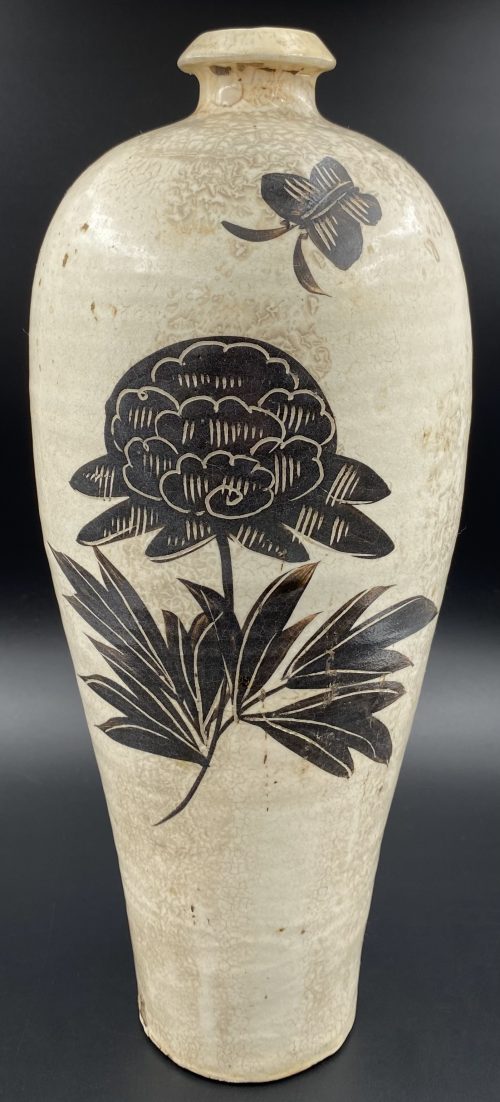 Typical meiping body, short neck, lipped rim; painted in the blackish-brown slip with two blossoms and butterflies under a clear glaze. The foot ring is unglazed exposing the brown body. China, the Yuan Dynasty [大元] (1279 – 1368). Diameter: 14 cm; Height: 30.5 cm.
Typical meiping body, short neck, lipped rim; painted in the blackish-brown slip with two blossoms and butterflies under a clear glaze. The foot ring is unglazed exposing the brown body. China, the Yuan Dynasty [大元] (1279 – 1368). Diameter: 14 cm; Height: 30.5 cm. -
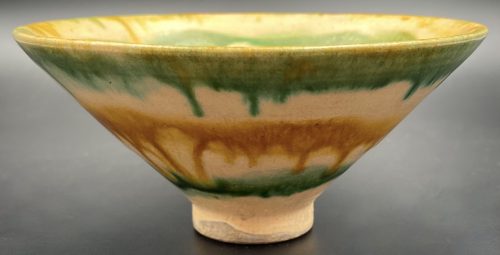 Footed conical bowl decorated with green and amber bleeding concentric circles on cream background inside and outside. Diameter: 13.5 cm, H: 6.2 cm;
Footed conical bowl decorated with green and amber bleeding concentric circles on cream background inside and outside. Diameter: 13.5 cm, H: 6.2 cm; -
 Iron tsuba of round form decorated with eight roundels – circular emblems of flowers and/or family crests (mon) made of cast brass, pierced and chiselled in kebori, and with flat brass inlay (hira-zōgan) of vines or leaves all over the plate. Both hitsu-ana are trimmed with brass. Nakago-ana of trapezoidal form. A distinctive character of this tsuba is a mon at 12 hours, depicting paulownia, or Kiri-mon [桐紋] – a symbol of the Toyotomi clan, led by Toyotomi Hideyoshi (豊臣 秀吉, 1537 – 1598). Kiri-mon was also used as fuku-mon (alternative family crests) for the Imperial Family and Imperial Court. Another important emblem at 6 o’clock is the Katakura clan [片倉氏, Katakura-shi] family crest. Katakura Kagetsuna (片倉 景綱, 1557 – 1615), a retainer of Date Masamune (伊達 政宗, 1567 – 1636); Kagetsuna was operational in Hideyoshi’s Odawara campaign in 1590, which ultimately ended the unification of Japan. Unsigned but may be attributed to Koike Yoshirō Naomasa or his workshop (Yoshirō, orKaga-Yoshirō school). Dimensions: Diameter: 85.5 mm; Thickness at seppa-dai: 5.0 mm.
Iron tsuba of round form decorated with eight roundels – circular emblems of flowers and/or family crests (mon) made of cast brass, pierced and chiselled in kebori, and with flat brass inlay (hira-zōgan) of vines or leaves all over the plate. Both hitsu-ana are trimmed with brass. Nakago-ana of trapezoidal form. A distinctive character of this tsuba is a mon at 12 hours, depicting paulownia, or Kiri-mon [桐紋] – a symbol of the Toyotomi clan, led by Toyotomi Hideyoshi (豊臣 秀吉, 1537 – 1598). Kiri-mon was also used as fuku-mon (alternative family crests) for the Imperial Family and Imperial Court. Another important emblem at 6 o’clock is the Katakura clan [片倉氏, Katakura-shi] family crest. Katakura Kagetsuna (片倉 景綱, 1557 – 1615), a retainer of Date Masamune (伊達 政宗, 1567 – 1636); Kagetsuna was operational in Hideyoshi’s Odawara campaign in 1590, which ultimately ended the unification of Japan. Unsigned but may be attributed to Koike Yoshirō Naomasa or his workshop (Yoshirō, orKaga-Yoshirō school). Dimensions: Diameter: 85.5 mm; Thickness at seppa-dai: 5.0 mm.
Kiri-mon

Katakura-mon
-
 Iron tsuba of round form profusely decorated with brass inlay of plants, birds, well, and family crests (mon) in suemon-zōgan technique and occasional brass dots (nail-heads) or ten-zōgan. Seppa-dai and kozuka-hitsu-ana outlined with brass inaly, possibly repaired: rope-shaped wire here and there replaced with flat wire. The plate is very thin, with remnants of lacquer. Ōnin school. Size: 75.8 x 75.2 x 2.3 mm. Weight: 77.5 g. On the front side (omote) motif includes the following elements (from 12 o'clock, clockwise):
Iron tsuba of round form profusely decorated with brass inlay of plants, birds, well, and family crests (mon) in suemon-zōgan technique and occasional brass dots (nail-heads) or ten-zōgan. Seppa-dai and kozuka-hitsu-ana outlined with brass inaly, possibly repaired: rope-shaped wire here and there replaced with flat wire. The plate is very thin, with remnants of lacquer. Ōnin school. Size: 75.8 x 75.2 x 2.3 mm. Weight: 77.5 g. On the front side (omote) motif includes the following elements (from 12 o'clock, clockwise):- Water plantain (a.k.a. arrowhead, or omodaka): "a perpetual plant of the water plantain family, was also called shōgunsō (victorious army grass). Because of this martial connotation, it was a design favored for the crests of samurai families" [see: Family Crests of Japan. // Stone Bridge Press, Berkeley, CA, 2007; p. 63].
- Heron (sagi): "...considered an emblem of longevity, and from China comes the practice of regarding the bird as a mount of the gods and the Taoist sennin. [...] heron also reflects an inauspicious connotation, for the word sagi is homophone for 'fraud' and 'false pretenses'." [see: Merrily Baird. Symbols of Japan. Thematic motifs in art and design. // Rizzoli international publications, Inc., 2001; p. 112]. Some may say, that this is not a heron but a crane (tsuru). It's very possible, and in this case the negative connotation is lost, but the reference to longevity and allusion to sennin remain.
- Pampas grass (susuki, or obana): as per Merrily Baird, p. 95 and John W. Dower, p. 66, pampas grass is one of the Seven Grasses of Autumn. When combined with flying wild gees, conveys strong autumnal mood.
- Plum blossom (ume): according to Merrily Baird, the flower has a vast variety of symbolic meanings, including longevity, and a reference to the Chinese Taoists. It is used in 80 family crests [see: Japanese Design Motifs: 4,260 Illustrations of Japanese Crests; Compiled by the Matsuya Piece-Goods Store; Translated by Fumie Adachi. // Dover Publications, Inc., 1972.] Plum is "celebrated for its sweet perfume, delicate blossoms, and habit of blooming at the end of winter".
- Tree flying wild geese (kari): "Wild geese arrive in large flocks in southern regions during the autumn months, and following their migratory instincts, head back north in spring" [Family Crests of Japan, pp. 85-86]. "The importance of geese in Japanese art was further secured by stories of several military heroes who had achieved victory in battle when a sudden breaking of ranks by flying geese signaled an ambush. The protective role of the birds led to their frequent use in decorating sword furnishings and possibly also their adoption as a family crest motif.Finally, the goose in Asia plays a role in religious traditions" [Merrily Baird, pp.111-112].
- Hikiryō (line, or bar, or stripe) - a symbol which consists of one, two, or three horizontal or vertical stripes in a circle. "In wartime, Japanese generals [...] surrounded their encampments with huge cloth curtains. Usually these were made of cloth sewn together horizontally and varying in color [...] to distinguish the individual general and his followers. The stripe thus assumed strong martial connotations, and became a mark of identification on personal military gear as well. In the early fourteenth century the heads of the Ashikaga and Nitta, then the two most powerful clans in Japan, both adopted stripe patterns as a family crest". [See: Family Crests of Japan, p. 111 and John W. Dower. The elements of Japanese design - A handbook of family crests, heraldry & symbolism. // Weatherhill, New York, Tokyo, 1985, p. 144].
- Hikiryō, see above.
- Pampas grass (susuki, or obana), see above.
- Bellflower (kikyo): One of the Seven Grasses of Autumn. "As a crest, it have been adopted among the warriors around the thirteenth century, primarily because of it's beauty" [John W. Dower, p. 48].
- Four flying wild geese (kari), see above.
- Weeping willow (yanagi): "It is commonly represented with water, snow, swallows, or herons. A branch of willow (yoshi) is one of the attributes of the Buddhist deity Senju Kannon (Thousand-Armed Kannon), who is said to use the branch to sprinkle the nectar of life contained in a vase. [Merrily Baird, pp. 66-67].
- Lone plum blossom in a well frame/crib (igeta, izitsu): "Well crib was one of the most popular motifs in Japanese heraldry". As a crest it may stay simply for the first character (i) of the family name, however, with a flower inside the well frame, and together with the other symbols present, it may aggravate the sense of autumn-ness. The ten-zōgan dots in this particular case may represent the snowflakes or autumn stars.
-
 Iron tsuba of round form with design of butterfly (left) and dragonfly (right) in openwork (sukashi), outlined with brass wire. Thin plate also decorated with five concentric circular rows of brass dots (nail heads) in ten-zōgan; brass wire outlines of the center of the plate. School: Ōnin ten-zogan. Late Muromachi period, 16th century. Diameter: 88 mm, thickness at seppa-dai: 3.1 mm. Another tsuba of similar design, Tōshō school, is illustrated in this collection; see TSU-0353.Reference to the design has been found at "Japanese Swords and Tsuba from the Professor A. Z. Freeman and the Phyllis Sharpe Memorial collections". Sotheby's, London, Thursday 10 April 1997; p. 18, item 37: "pierced with two large formalised butterflies...".
Iron tsuba of round form with design of butterfly (left) and dragonfly (right) in openwork (sukashi), outlined with brass wire. Thin plate also decorated with five concentric circular rows of brass dots (nail heads) in ten-zōgan; brass wire outlines of the center of the plate. School: Ōnin ten-zogan. Late Muromachi period, 16th century. Diameter: 88 mm, thickness at seppa-dai: 3.1 mm. Another tsuba of similar design, Tōshō school, is illustrated in this collection; see TSU-0353.Reference to the design has been found at "Japanese Swords and Tsuba from the Professor A. Z. Freeman and the Phyllis Sharpe Memorial collections". Sotheby's, London, Thursday 10 April 1997; p. 18, item 37: "pierced with two large formalised butterflies...".
TSU-0353: Tōshō tsuba, Muromachi period.

A kamakura-bori tsuba. Momoyama period. Freeman & Sharpe Memorial Collections.
-
 Iron tsuba of round form with circular iron wire fastened to the surface with iron and brass staples (mukade-zōgan); brass ring about 2.5 mm wide along the rim with chisel marks. Design repeats on the reverse. Copper sekigane. Early Edo, 17th century. Size: Height: 83.3 mm; width 83.9 mm; thickness at seppa-dai: 4.5 mm. Weight 173.6 g. Design is thought to resemble a centipede. "Centipede-like inlay (mukade zogan) of alternating iron and brass staples produce an appearance that was particularly favored by Takeda Shingen (1521-1573), one of the most powerful warlords of his time. The centipede is sacred to Bishamon (God of War) and especially propitious for a warrior. Shingen type, 16th century.” [The Peabody Museum collection of Japanese sword guards with selected pieces of sword furniture, by John D. Hamilton. Photographs by Mark Sexton. Salem, MA, 1975.] See also: http://varshavskycollection.com/shingen-tsuba/ SOLD
Iron tsuba of round form with circular iron wire fastened to the surface with iron and brass staples (mukade-zōgan); brass ring about 2.5 mm wide along the rim with chisel marks. Design repeats on the reverse. Copper sekigane. Early Edo, 17th century. Size: Height: 83.3 mm; width 83.9 mm; thickness at seppa-dai: 4.5 mm. Weight 173.6 g. Design is thought to resemble a centipede. "Centipede-like inlay (mukade zogan) of alternating iron and brass staples produce an appearance that was particularly favored by Takeda Shingen (1521-1573), one of the most powerful warlords of his time. The centipede is sacred to Bishamon (God of War) and especially propitious for a warrior. Shingen type, 16th century.” [The Peabody Museum collection of Japanese sword guards with selected pieces of sword furniture, by John D. Hamilton. Photographs by Mark Sexton. Salem, MA, 1975.] See also: http://varshavskycollection.com/shingen-tsuba/ SOLD -
 Tsuba of chrysanthemoid form (kikka-gata) with yamagane core and woven copper wire pattern. Copper sekigane. Shingen school. Height: 70.2 mm; Width 67.2 mm; Thickness at seppa-dai: 3.4-3.6 mm, overall 7.3 mm. Weight 82.7 g Inscription on the wooden box reads: "Muromachi period Mumei Zōgan Shingen Tsuba" Muromachi period, 16th century. Age attribution is based on the fact that the core is made of yamagane; later copies of Edo period are usually made of iron. This small and light tsuba was likely mounted on a combat sword, while larger and much heavier woven wire Shingen tsuba of Edo period were of purely decorative purpose. http://varshavskycollection.com/shingen-tsuba/
Tsuba of chrysanthemoid form (kikka-gata) with yamagane core and woven copper wire pattern. Copper sekigane. Shingen school. Height: 70.2 mm; Width 67.2 mm; Thickness at seppa-dai: 3.4-3.6 mm, overall 7.3 mm. Weight 82.7 g Inscription on the wooden box reads: "Muromachi period Mumei Zōgan Shingen Tsuba" Muromachi period, 16th century. Age attribution is based on the fact that the core is made of yamagane; later copies of Edo period are usually made of iron. This small and light tsuba was likely mounted on a combat sword, while larger and much heavier woven wire Shingen tsuba of Edo period were of purely decorative purpose. http://varshavskycollection.com/shingen-tsuba/ -
 Iron tsuba of otafuku-gata form decorated on the face with death and autumn motifs: autumnal grasses and flowers in yellow brass and shakudō, skull, limb bone and sternum inlaid in shakudō. On the reverse the plate is inlaid in red copper with a chrysanthemum and maple leaves floating in stylized water streams. "Plants floating atop water form common motifs, as occurs with chrysanthemums, maple leaves, and cherry blossoms, in particular." [Merrily Baird]. Such plants may be used as a family crest (mon), or may be just a reminder of a floating nature of life. Momoyama period, late 15th century. Dimensions: 75.3 x 69.9 x 4.3 mm.
Iron tsuba of otafuku-gata form decorated on the face with death and autumn motifs: autumnal grasses and flowers in yellow brass and shakudō, skull, limb bone and sternum inlaid in shakudō. On the reverse the plate is inlaid in red copper with a chrysanthemum and maple leaves floating in stylized water streams. "Plants floating atop water form common motifs, as occurs with chrysanthemums, maple leaves, and cherry blossoms, in particular." [Merrily Baird]. Such plants may be used as a family crest (mon), or may be just a reminder of a floating nature of life. Momoyama period, late 15th century. Dimensions: 75.3 x 69.9 x 4.3 mm. -

Tsuba of oval form decorated with clematis six-petal flowers, tendrils, and leaves in cast brass with details carved in kebori, inlaid on iron plate carved in low relief (kebori and sukidashi-bori). Hitsu-ana plugged with shakudō. Copper sekigane.
Heianjō (or Ōnin) school. Unsigned. Mid Muromachi period (1454-1513). Dimensions: 87.2 x 84.3 x 4.3 mm. Tsuba is illustrated and described in Gary D. Murtha's "Onin-Heianjo-Yoshiro" book on pages 38-39. Mid-Muromachi is the age attribution by Gary. “A picture book of Japanese sword guards. Victoria & Albert Museum“, published in 1927 presents us with a somewhat similar tsuba: "Floral ornament. Iron, with brass incrustation". V&A attributes the tsuba to Ōnin style, 16th century.
-

Iron tsuba with chrysanthemum design in openwork (sukashi). Copper sekigane.
Late Heian through Kamakura period (ca. 1150 - 1200's).
Size: 78.4 x 60.9 x 3.5 mm; weight: 45.7 g
Provenance: Boris Markhasin Message from Boris Markhasin (13-AUG-2019): It is a very rudimentary tachi tsuba, and the iron is old and really nothing to draw attention. However, this is a very old tsuba, and that is what makes it very special and an important study piece. This tsuba likely dates to the late Heian through Kamakura (ca. 1150 - 1200's) -- by consensus, since such examples are extremely rare, and none are mounted to my knowledge, so few direct analogues. The form is interesting for a variety of reasons. The smaller size, an oval form is associated more with 12th/13th c styles. The sukashi kiku motif is very interesting as it clearly pushes back the dating of large scale sukashi far back in time. This shouldn't be surprising, but for some reason, we (really mainly westerners) naively tend to associate sukashi with the Muromachi and younger. The two missing spokes are by consensus likely later removals to accommodate kozuka and kogai -- but this is not certain, and it could be an original styling. A key kantei point is the elongate, narrow, slightly squared seppa dai. This is a characteristic of early koshirae, which were much thinner and more delicate than the types we are used to seeing that date pretty much to the late Muromachi and later. I am always amazed when I have a chance to interrogate early koshirae at how thin they are - I want to call them fragile, but they were actually quite resilient. The walls were super thin, but the top and bottom edges were a bit thicker, providing a bit of structural support... but this is another thread topic. Of all the tsuba I have owned, this is the tsuba that has most clearly reflected the shape of the old style of saya / tsuka. -
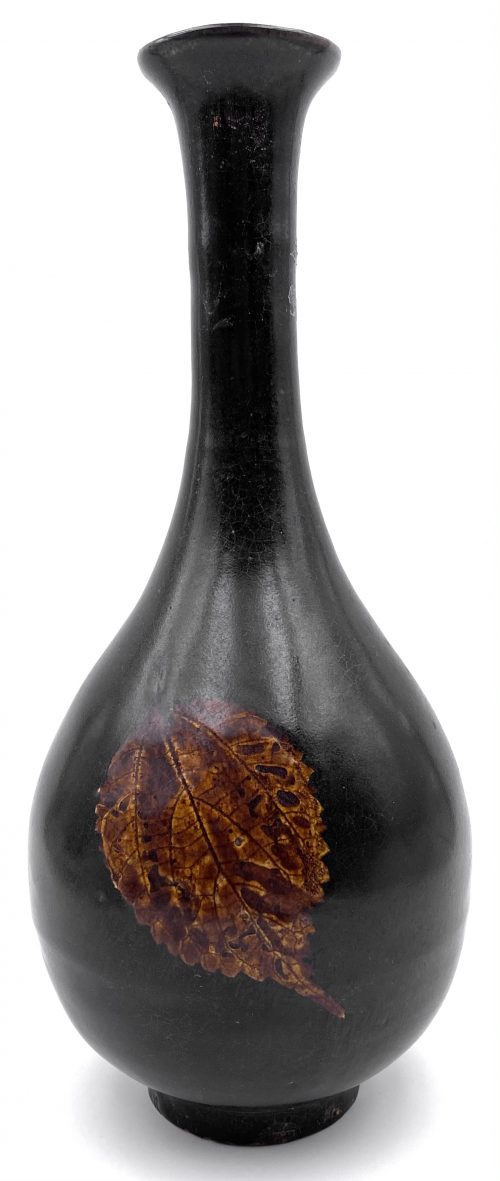 Jizhou black glaze bottle decorated with a leaf, placed on to the glaze before firing, and burnt away in the kiln to leave its pattern. Foot unglazed. China, the Song dynasty [宋朝] (960 – 1279). Height: 27.5 cm.
Jizhou black glaze bottle decorated with a leaf, placed on to the glaze before firing, and burnt away in the kiln to leave its pattern. Foot unglazed. China, the Song dynasty [宋朝] (960 – 1279). Height: 27.5 cm. -
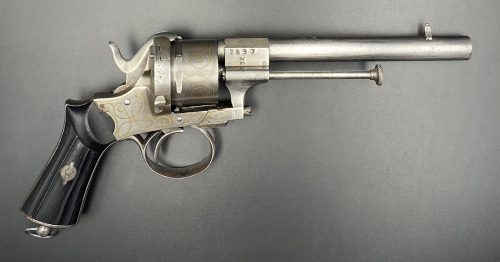 Serial number 8697, barrel 14.5 cm, calibre 9 mm Lefaucheux M-1858 double-action pin-fire revolver manufactured in the late 1860-s. Produced in France with no retailers marking but having French proofs on front of the cylinder and right side of barrel trunnion. The metal remains in the white with small gold wire inlays. Fluted 2 piece ebony grips. This pattern has been observed in civil war photographs and excavated from battlefields and camps in the United States. Dimensions: L: 25 cm; H: 13 cm; Barrel: 14.5 cm.
Serial number 8697, barrel 14.5 cm, calibre 9 mm Lefaucheux M-1858 double-action pin-fire revolver manufactured in the late 1860-s. Produced in France with no retailers marking but having French proofs on front of the cylinder and right side of barrel trunnion. The metal remains in the white with small gold wire inlays. Fluted 2 piece ebony grips. This pattern has been observed in civil war photographs and excavated from battlefields and camps in the United States. Dimensions: L: 25 cm; H: 13 cm; Barrel: 14.5 cm. -
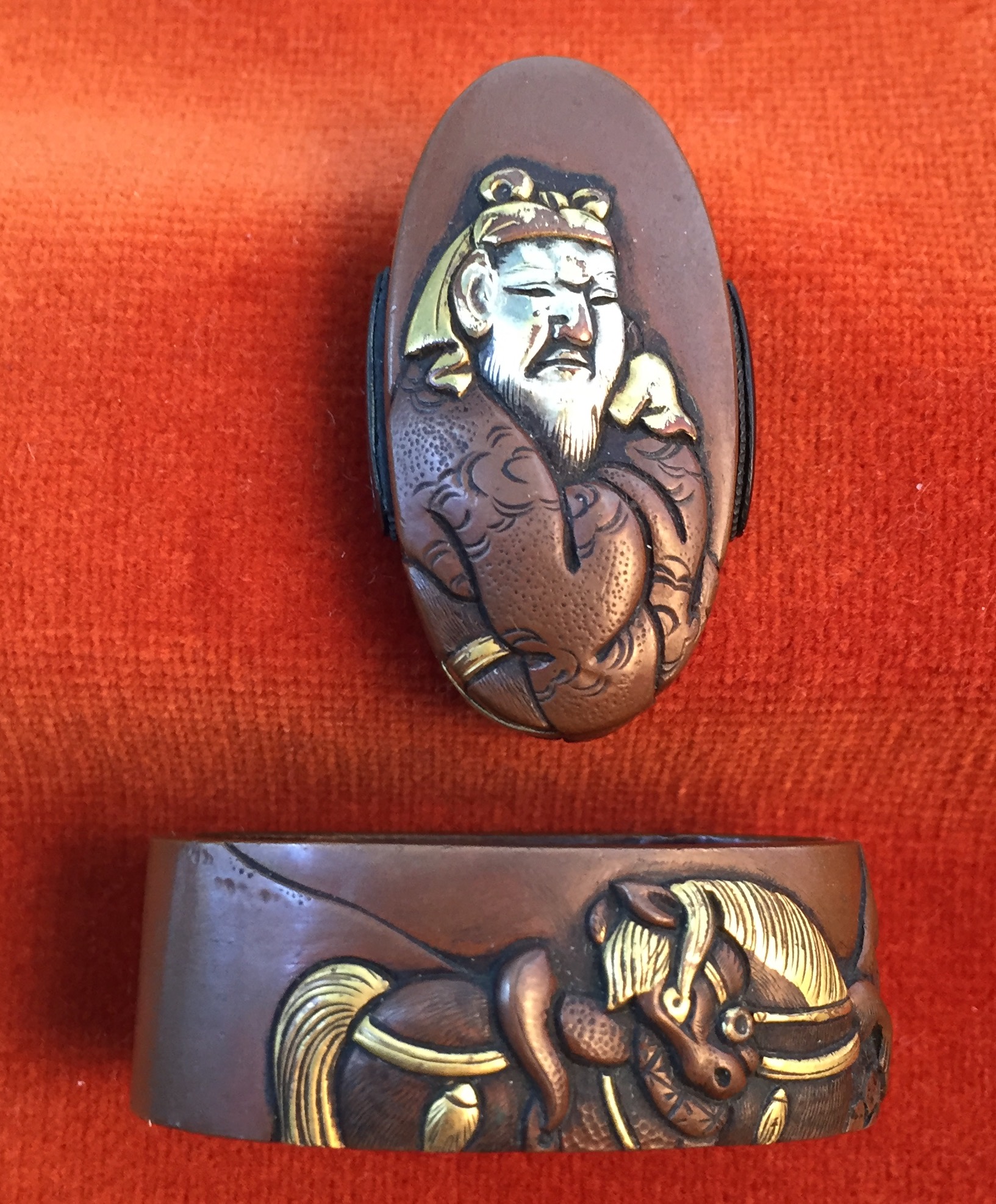 Fuchi: 38 x 22 x 14 mm. Kashira: 33 x 18 x 9 mm Techniques: Usu-shishiai-bori (薄肉合彫) – low-relief, zogan.
Fuchi: 38 x 22 x 14 mm. Kashira: 33 x 18 x 9 mm Techniques: Usu-shishiai-bori (薄肉合彫) – low-relief, zogan. -
 Iron tsuba of round form with design of triple diamond (matsukawa-bishi) in openwork (sukashi). Square rim. Ko-Tosho school. Nanbokucho period: Late 14th century (Oan/Eiwa era). Height: 92.3 mm. Width: 92.3 mm. Rim thickness: 2.5 mm. Center thickness: 3.0 mm. Provenance: Sasano Masayuki Collection, № 15: "Two small lozenges are attached to each end of a larger lozenge. Most Ko-tosho tsuba have inspirational designs, however this has a rather casual appearance, although it represents the unstable political situation at the time".
Iron tsuba of round form with design of triple diamond (matsukawa-bishi) in openwork (sukashi). Square rim. Ko-Tosho school. Nanbokucho period: Late 14th century (Oan/Eiwa era). Height: 92.3 mm. Width: 92.3 mm. Rim thickness: 2.5 mm. Center thickness: 3.0 mm. Provenance: Sasano Masayuki Collection, № 15: "Two small lozenges are attached to each end of a larger lozenge. Most Ko-tosho tsuba have inspirational designs, however this has a rather casual appearance, although it represents the unstable political situation at the time". -
 Iron tsuba of round form with design of rabbit (usagi) in openwork (sukashi) and inlaid with designs of plants and family crests (mon) in suemon-zōgan. A branch with lonely leaf, half chrysanthemum, and flying wild geese on the face represent autumnal connotations. The same motif is complemented by a clove (choji) on the reverse. The family crests (mon) include: interlocked rings (kanawa; wachigai), three encircled lines or stripes (hikiryo), bit or muzzle (kutsuwa - horse's harness element with possible christian symbolism), and encircled triangle (uroko, fish scale). Brass wire trim around the openwork elements and the seppa-dai, scalloped wire inlay around the hitsu-ana. Iron is dark, almost black. Brass or copper elements vary in shades of lighter and darker yellow with red-ish hue. Ōnin school. Late Muromachi period, 16th century. Height: 89.6 mm; Width: 89.3 mm; Thickness at seppa-dai: 3.0 mm. Weight: 129.7 g.
Iron tsuba of round form with design of rabbit (usagi) in openwork (sukashi) and inlaid with designs of plants and family crests (mon) in suemon-zōgan. A branch with lonely leaf, half chrysanthemum, and flying wild geese on the face represent autumnal connotations. The same motif is complemented by a clove (choji) on the reverse. The family crests (mon) include: interlocked rings (kanawa; wachigai), three encircled lines or stripes (hikiryo), bit or muzzle (kutsuwa - horse's harness element with possible christian symbolism), and encircled triangle (uroko, fish scale). Brass wire trim around the openwork elements and the seppa-dai, scalloped wire inlay around the hitsu-ana. Iron is dark, almost black. Brass or copper elements vary in shades of lighter and darker yellow with red-ish hue. Ōnin school. Late Muromachi period, 16th century. Height: 89.6 mm; Width: 89.3 mm; Thickness at seppa-dai: 3.0 mm. Weight: 129.7 g. -

Copper tsuba of oval form carved in kebori and katakiribori with Tekkai Sennin sitting under bamboo on the face and with a pine tree on the back. Ishime-ji treated surface.
Signed on the reverse: Jōi (乗 意).
Edo period (First half of 18th century). Dimensions: 69.6 x 66.5 x 4.5 mm Sugiura Jōi (杉 浦 乗 意) was a master of Nara School in Edo; he was a student of Toshinaga [M. Sesko, 'Genealogies', p. 32]. "Sugiura Jōi (1701-1761) made many fuchigashira and kozuka, tsuba are rather rare." [M. Sesko, The Japanese toso-kinko Schools]. -

Iron tsuba of elongated round form with brown (chocolate) patina. The surface is carved with file strokes (sujikai-yasurime) to imitate heavy rain. The design of a bird drinking water from a bucket hanging on a rope is carved in low relief (sukidashi-bori); the rope is inlaid in gold. The well structure on the reverse, carved in low relief. Nakago-ana is enlarged and plugged with copper sekigane. Unsigned.
Edo period.Size: Height: 75.1 mm; Width: 68.3 mm; Thickness: 4.6 mm; Weight: 134 g.
Unsigned.
SOLD -
 Iron tsuba of round form decorated with eight roundels – circular emblems of flowers and/or family crests (mon) made of cast brass, pierced and chiselled in kebori, and with flat brass inlay (hira-zōgan) of vines or leaves all over the plate. Both hitsu-ana trimmed with brass. Nakago-ana of trapezoidal form. A distinctive character of this tsuba is a mon at 6 hours depicting tomoe (comma). Yoshirō school (Kaga-Yoshirō). Attributed to Koike Yoshirō Naomasa himself. Unsigned. The Momoyama or early Edo period, end of the 16th to the first half of the 17th century (1574-1650). Size: Diameter 82.0 mm, thickness 3.8 mm at seppa-dai, 3.4 mm at rim.
Iron tsuba of round form decorated with eight roundels – circular emblems of flowers and/or family crests (mon) made of cast brass, pierced and chiselled in kebori, and with flat brass inlay (hira-zōgan) of vines or leaves all over the plate. Both hitsu-ana trimmed with brass. Nakago-ana of trapezoidal form. A distinctive character of this tsuba is a mon at 6 hours depicting tomoe (comma). Yoshirō school (Kaga-Yoshirō). Attributed to Koike Yoshirō Naomasa himself. Unsigned. The Momoyama or early Edo period, end of the 16th to the first half of the 17th century (1574-1650). Size: Diameter 82.0 mm, thickness 3.8 mm at seppa-dai, 3.4 mm at rim. -
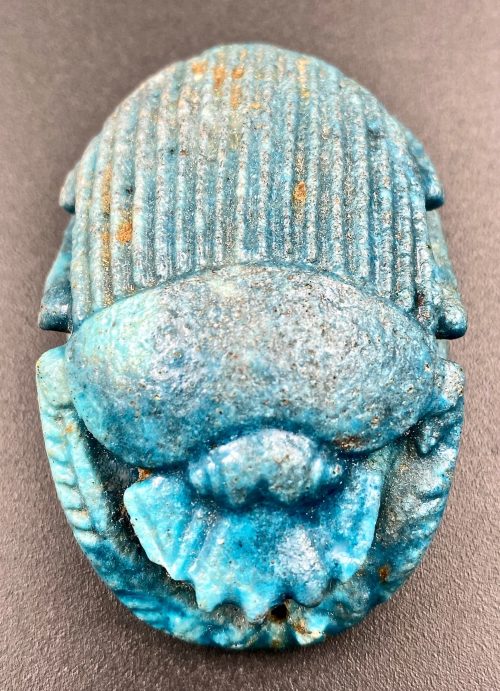 Egypt, Late Period. The oval amulet with multiple pierced holes for stitching to the outer garments of a mummy or the mummy wrappings, reeded wings and braided claws, marine blue in colour. According to the Brooklyn Museum, such faience amulets formed part of the beadwork pattern and served to protect the mummy through their magical properties. It served as a substitute heart that would ensure continued existence in the hereafter. A similar example at the Brooklyn Museum dated ca. 712-342 BC. Dimensions: 55 x 37 mm Provenance: The Collection of Erwin Harvith (1918 – 2011) and Sylvia Redblatt Harvith (1920 – 2015), Detroit, MI, acquired in 1972 directly from the Collection of Moshe Dayan, (משה דיין; 1915 – 1981), an Israeli military leader and politician. Exhibited: Jewish Museum, New York, NY, "Culture and Continuity – The Jewish Journey", 1975.
Egypt, Late Period. The oval amulet with multiple pierced holes for stitching to the outer garments of a mummy or the mummy wrappings, reeded wings and braided claws, marine blue in colour. According to the Brooklyn Museum, such faience amulets formed part of the beadwork pattern and served to protect the mummy through their magical properties. It served as a substitute heart that would ensure continued existence in the hereafter. A similar example at the Brooklyn Museum dated ca. 712-342 BC. Dimensions: 55 x 37 mm Provenance: The Collection of Erwin Harvith (1918 – 2011) and Sylvia Redblatt Harvith (1920 – 2015), Detroit, MI, acquired in 1972 directly from the Collection of Moshe Dayan, (משה דיין; 1915 – 1981), an Israeli military leader and politician. Exhibited: Jewish Museum, New York, NY, "Culture and Continuity – The Jewish Journey", 1975. -
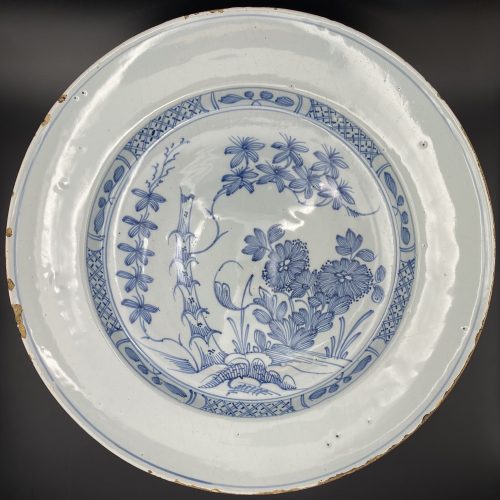 Round plate with a blue and white design of blossoming bamboo and chrysanthemums in the centre with a border of lattice and floral sprays. Diameter: 34 cm, Haight: 5.5 cm.
Round plate with a blue and white design of blossoming bamboo and chrysanthemums in the centre with a border of lattice and floral sprays. Diameter: 34 cm, Haight: 5.5 cm. -

Small iron tsuba for a dagger (tantō), of quatrefoil form (mokkō-gata), with raised rim (mimi), decorated with flat brass inlay (hira-zōgan) to form an abstract design alluding to the mushroom of immortality (reishi). Opening (hitsu-ana) to the left of nakaga-ana probably cut later and fitted with shakudo sekigane. Maker's signature on seppa-dai: Koike Naomasa (小池 直正).
Momoyama period: End of the 16th - beginning of the 17th century. Dimensions: Height 53.7 mm; Width: 45.5 mm; Thickness at centre: 3.5 mm; at rim: 4.9 mm. Other examples of signed Koike Naomasa work in this collection: TSU-0346. Reference: The closest example in literature is in Compton Collection (II): №11 with the description: “A Koike School tsuba, Edo period (circa 1625), signed Koike Yoshiro. Sheet-brass flush inlay of cloud forms and wire inlay creating the same shape. Koike Yoshiro Naomasa worked from the Keicho to the Genna periods (1596-1623). He arrived in Kyoto from Kaga.” [Japanese Swords and Sword Fittings from the Collection of Dr. Walter Ames Compton (Part II) / Sebastian Izzard, Yoshinori Munemura. — Christie's, New York, October 22, 1992]. See: Yoshirō tsuba.
-
 Iron tsuba of round form with design of rudder, paddle, and stars in small openwork (ko-sukshi) outlined with brass wire, and further decorated with inlay of five concentric rows of brass dots or nail heads (ten-zōgan) and circular brass wire inlaid inside the innermost row of dots. Two lower round openings may also serve as udenuki-ana. Copper sekigane. Unsigned. Late Muromachi or Momoyama period, 16th century. Diameter: 90.4 x 89.8 x 2.8 mm.
Iron tsuba of round form with design of rudder, paddle, and stars in small openwork (ko-sukshi) outlined with brass wire, and further decorated with inlay of five concentric rows of brass dots or nail heads (ten-zōgan) and circular brass wire inlaid inside the innermost row of dots. Two lower round openings may also serve as udenuki-ana. Copper sekigane. Unsigned. Late Muromachi or Momoyama period, 16th century. Diameter: 90.4 x 89.8 x 2.8 mm. -
 Ōnin shinchū ten-zōgan tsuba. Iron tsuba of round form decorated with full moon and bamboo shoot (takenoko) motif executed in openwork (sukashi) and inlaid with four concentric rows of brass dots (ten-zōgan). The innermost row of dots as well as the sukashi openings outlined with the inlaid linear brass wire. Late Muromachi period, 16th century. Diameter: 82.0 mm; Thickness: 2.8 mm Cited from Merrily Baird. Symbols of Japan. Thematic motifs in art and design. Rizzoli international publications, Inc., 2001, p. 72: "In Japanese art, the appearance of bamboo shoots is often without symbolic meaning. In other cases, however, the shoots are emblematic of Moso (Chinese: Meng Tsung/Meng Zong), a paragon of filial piety who dug through snow to find shoots for his mother. ... especially in miniature art forms, let bamboo shoots alone speak for the full story." The full story is this (See THE TWENTY-FOUR PARAGONS OF FILIAL PIETY [ERSHISI XIAO]):
Ōnin shinchū ten-zōgan tsuba. Iron tsuba of round form decorated with full moon and bamboo shoot (takenoko) motif executed in openwork (sukashi) and inlaid with four concentric rows of brass dots (ten-zōgan). The innermost row of dots as well as the sukashi openings outlined with the inlaid linear brass wire. Late Muromachi period, 16th century. Diameter: 82.0 mm; Thickness: 2.8 mm Cited from Merrily Baird. Symbols of Japan. Thematic motifs in art and design. Rizzoli international publications, Inc., 2001, p. 72: "In Japanese art, the appearance of bamboo shoots is often without symbolic meaning. In other cases, however, the shoots are emblematic of Moso (Chinese: Meng Tsung/Meng Zong), a paragon of filial piety who dug through snow to find shoots for his mother. ... especially in miniature art forms, let bamboo shoots alone speak for the full story." The full story is this (See THE TWENTY-FOUR PARAGONS OF FILIAL PIETY [ERSHISI XIAO]):Tears That Brought Bamboo-shoots From the Frozen Earth: Meng Zong Meng Zong lived during the Three Kingdoms Period of China's past. His father died when he was young, and he and his mother struggled to survive. One winter his mother was stricken with a serious illness, and craved some bamboo-shoot broth as medicine. But in the depths of winter, with snow and ice blanketing the ground, where was anyone to find fresh bamboo shoots, shoots that emerge only in the warm months? Nonetheless, Meng Zong, to avoid disappointing his mother, bravely fetched his shovel and went out into the white landscape in search of bamboo shoots. In the thicket he found only frosted leaves and green stalks coated with snowflakes and ice. Look as he might, there were simply no fresh shoots growing in the winter. The thought of his poor mother lying sick on her bed, waiting for bamboo-broth medicine, made his heartache. Uncontrollably, tears began to fall in rivers to the ground beneath the tall, emerald canes. Even now, as his tears flowed down, he kept a light of faith in his heart. If he was truly sincere in his search, perhaps.... Just then Meng Zong nearly tripped and fell over a sharply protruding lump of earth. He quickly knelt down and knocked aside the dirt with his trembling fingers. How uncanny! Underneath his frozen hands he discovered a bed of fresh, tender bamboo shoots! Overjoyed, he gathered up a coatful and carried them back home. The broth that he quickly set stewing in the pot soon cured his mother's illness. The neighbors, hearing the story, exclaimed that it was the strength of his sincere, unselfish, filial resolve that inspired heaven and earth to respond, and to bring up, out of season, the fresh shoots that cured his mother's disease. Before Meng Zong's prayers generated this miracle, it was normally considered impossible for bamboo shoots to grow in the winter. After the nmiracle took place, however, people were able to gather and to eat bamboo shoots all year round. The winter variety that existed hereafter became known as "winter shoots." The villagers were deeply influenced by Meng Zong's courage and devotion. They renamed the spot where the event took place, "Meng Zong's Bamboo Grove". We can now enjoy bamboo sprouts during the winter as well, and as we do so, it is fitting to recollect Meng Zong's outstanding example of filial respect, and reflect on our conduct as sons and daughter of our parents. A verse in his honor says, His teardrops transformed winter at the roots; Up from the ice crept tender bamboo shoots. Instantly, the winter-sprouts matured; Heaven's will: a happy, peaceful world.
-
 A very large and very thin iron tsuba of round form decorated with design of formalized butterfly and dragonfly in openwork (sukashi). The characteristics of the plate resemble those of Kamakura period ko-tōshō tsuba. However, the design seems too 'modern' to me, but it's hard to tell; it may be a late Muromachi or Momoyama period work. Tōshō or Ko-Tōshō school (or a Katchushi). Muromachi period. Dimensions: 99.6 x 100.5 x 2.1 mm. This is what Jim Gilbert says about old tsuba:
A very large and very thin iron tsuba of round form decorated with design of formalized butterfly and dragonfly in openwork (sukashi). The characteristics of the plate resemble those of Kamakura period ko-tōshō tsuba. However, the design seems too 'modern' to me, but it's hard to tell; it may be a late Muromachi or Momoyama period work. Tōshō or Ko-Tōshō school (or a Katchushi). Muromachi period. Dimensions: 99.6 x 100.5 x 2.1 mm. This is what Jim Gilbert says about old tsuba:"Traditionally the old iron plate tsuba are classified into Ko Tosho (old sword smith), and Ko Katchushi (old armor maker) styles. It is sometimes difficult to justify attribution of a given tsuba to the Tosho or Katchushi category. Generally guards with raised rims or relatively complex designs tend to be assigned to Katchushi. This is basically a convention we follow out of habit and convenience." [...] "In Token Kai-Shi part six, Articles by Akiyama Kyusaku, Robert Haynes comments: "…from 1300 to 1400 over 150,000 MOUNTED swords were made in Japan for export alone. This means that over four tsuba a day were made for 100 years. This would mean that at least 3000 persons were making nothing but tsuba, let alone all the other fittings needed to complete these swords. With sword smiths, fittings makers and all the other artists need to complete a sword for export, at least 10,000 sword artists were working together, in any one of these hundred years."
Reference to design can be found at "Japanese Swords and Tsuba from the Professor A. Z. Freeman and the Phyllis Sharpe Memorial collections" / Sotheby's, London, Thursday 10 April 1997; p. 18-19, lot № 37: "A Kamakura-bori Tsuba, Momoyama Period. ...pierced with two large formalised butterflies..."Reference to design in this collection: TSU-0319.
A Kamakura-bori tsuba of octagonal form, Momoyama period.

TSU-0319. Ōnin ten-zōgan tsuba, Muromachi period.
-
 Ko-kinko ymagane cast tsuba of mokko form (kirikomi-mokkō-gata) with chiseled diaper pattern of double head waves on both sides and a rabbit cast and carved with its eye inlaid in yellow metal (gold or brass) on the face. Fukurin which holds together the sandwiched layers of metal (sanmai) is about 2.4 mm wide. A look-a-like tsub of oval form instead of mokko-gata is illustrated at Robert E. Haynes's Catalog #3,1982 on page 11, lot 15: "Rare design in style of Sanmai (three layers) / Wasei work. With yamagane core and heavy rim cover. The web plates are carved with double head Goto style waves and the face has a fox. The web plates were riveted at the seppadai. See Lot 4, page 8. Ca. 1350. Ht. 6.6 cm, th. 3 mm" [underscore mine]. Quality of photo is so poor that I decided not to provide it here. Muromachi (if we follow Robert) or Momoyama period. The Momoyama attribution is mostly based on a fact that "waves and rabbit" motif became most popular in Momoyama times. Size: 68.5 x 59.8 x 4.0 mm. NBTHK Certificate № 423120. This tsuba is listed at Yakiba website with the following passage: "Attributions as well as dating of this type of tsuba has been the subject debate over the years. There are those who believe these type of tsuba to be ko-Mino (early Mino School) tsuba, others believe them to be tachi-kanaguchi tsuba. Still others insist they are simply ko-kinko (early soft metal) tsuba. This tsuba was authenticated and determined to be "Ko-Kinko" by the NBTHK". Oval form tsuba with the same design can be found in this collection - TSU-0323.
Ko-kinko ymagane cast tsuba of mokko form (kirikomi-mokkō-gata) with chiseled diaper pattern of double head waves on both sides and a rabbit cast and carved with its eye inlaid in yellow metal (gold or brass) on the face. Fukurin which holds together the sandwiched layers of metal (sanmai) is about 2.4 mm wide. A look-a-like tsub of oval form instead of mokko-gata is illustrated at Robert E. Haynes's Catalog #3,1982 on page 11, lot 15: "Rare design in style of Sanmai (three layers) / Wasei work. With yamagane core and heavy rim cover. The web plates are carved with double head Goto style waves and the face has a fox. The web plates were riveted at the seppadai. See Lot 4, page 8. Ca. 1350. Ht. 6.6 cm, th. 3 mm" [underscore mine]. Quality of photo is so poor that I decided not to provide it here. Muromachi (if we follow Robert) or Momoyama period. The Momoyama attribution is mostly based on a fact that "waves and rabbit" motif became most popular in Momoyama times. Size: 68.5 x 59.8 x 4.0 mm. NBTHK Certificate № 423120. This tsuba is listed at Yakiba website with the following passage: "Attributions as well as dating of this type of tsuba has been the subject debate over the years. There are those who believe these type of tsuba to be ko-Mino (early Mino School) tsuba, others believe them to be tachi-kanaguchi tsuba. Still others insist they are simply ko-kinko (early soft metal) tsuba. This tsuba was authenticated and determined to be "Ko-Kinko" by the NBTHK". Oval form tsuba with the same design can be found in this collection - TSU-0323.
TSU-0323. Ko-kinko yamagane tsuba with waves and rabbit motif.
-

Iron tsuba of round form pierced (sukashi) and inlaid in flat (hira-zōgan) and cast brass (suemon-zōgan), details carved in kebori, with design of two phoenixes, bamboo, and paulownia leaves and flowers (kiri-mon) on both sides. According to seller: Bizen-Yoshirō school (or Heianjō school). Unsigned.
Momoyama period. End of the 16th - beginning of the 17th century. Dimensions: Diameter: 99.5 mm; Thickness: 2.1 mm at centre; 4.3 mm at the rim. According to Merrily Baird (Symbols of Japan), "bamboo teamed with paulownia blossoms or with paulownia and the phoenix, in reference to the Chinese legend that the phoenix perches only on the paulownia and eats only the bamboo". Citation from http://www.clevelandart.org/art/1986.2.1: "The immense heraldic birds on display [...] reflect the Momoyama era's spirit of newly gained self-confidence and an affinity for grand expressive statements in painting, architecture, the textile and ceramic arts, as well as garden design. While that period preceded the arrival of prosperity, it clearly marked an extraordinary moment in Japanese cultural history, one frequently compared with the twelfth century of the Heian period. [...] Rather than an emblem of immortality, as it is in Western lore, in Japan, the phoenix evolved out of its origins in Chinese mythology to become, by the sixteenth century, an auspicious symbol of political authority. Together with clusters of the distinctively shaped paulownia leaves, this long-tailed, mythical bird [...] proclaiming an air of graceful command". -
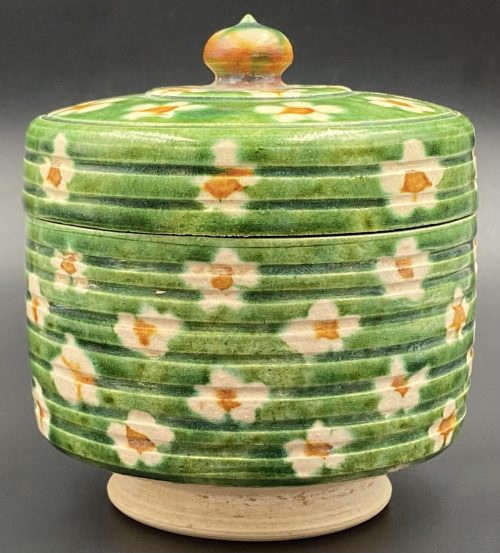 Green, mottled (white, yellow, brown) glazed earthenware jar or a circular box with a cover, on an unglazed foot decorated with florets. The cover has a small knop. Ivory glaze inside. China, the Tang dynasty [唐朝] (618 – 907). Diameter: 10 cm; Height: 10 cm.
Green, mottled (white, yellow, brown) glazed earthenware jar or a circular box with a cover, on an unglazed foot decorated with florets. The cover has a small knop. Ivory glaze inside. China, the Tang dynasty [唐朝] (618 – 907). Diameter: 10 cm; Height: 10 cm. -
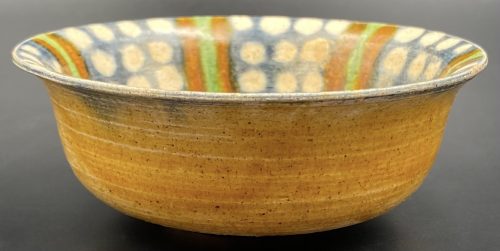 Small stoneware cup with rounded sides raising from a short foot to an inverted rim; glazed inside with a green and brown six-petal design on a blue background with creem dots. Amber glaze outside, blue bottom, foot unglazed. Dia: 10 cm; H: 4 cm.
Small stoneware cup with rounded sides raising from a short foot to an inverted rim; glazed inside with a green and brown six-petal design on a blue background with creem dots. Amber glaze outside, blue bottom, foot unglazed. Dia: 10 cm; H: 4 cm. -
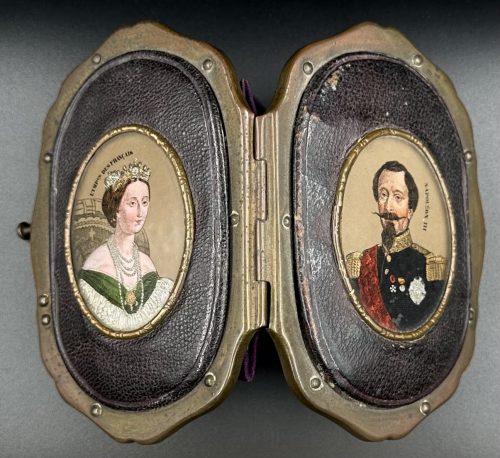 Coin purse, or porte-monnaie, made of patinated copper alloy, full-grain brown leather outside and purple inside, with a clutch and a hinge, and an oval miniature bust portrait on each side, painted in colour with gold and silver, by an anonymous artist after Franz Xaver Winterhalter, inscribed NAPOLÉON III and L'IMPCE DES FRANÇAIS, respectively, under glass. Dimensions: 97 x 67 x 18 mm. Contributors: Napoleon III [Charles Louis Napoléon Bonaparte] (French, 1808 – 1873) – character/sitter. Eugénie de Montijo [María Eugenia Ignacia Agustina de Palafox y Kirkpatrick] (Spanish-French, 1826 – 1920) – character/sitter. Franz Xaver Winterhalter (German, 1805 – 1873) – artist.
Coin purse, or porte-monnaie, made of patinated copper alloy, full-grain brown leather outside and purple inside, with a clutch and a hinge, and an oval miniature bust portrait on each side, painted in colour with gold and silver, by an anonymous artist after Franz Xaver Winterhalter, inscribed NAPOLÉON III and L'IMPCE DES FRANÇAIS, respectively, under glass. Dimensions: 97 x 67 x 18 mm. Contributors: Napoleon III [Charles Louis Napoléon Bonaparte] (French, 1808 – 1873) – character/sitter. Eugénie de Montijo [María Eugenia Ignacia Agustina de Palafox y Kirkpatrick] (Spanish-French, 1826 – 1920) – character/sitter. Franz Xaver Winterhalter (German, 1805 – 1873) – artist.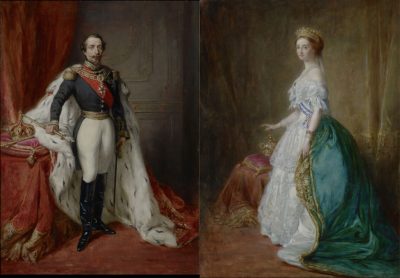
-
 Iron tsuba of quatrefoil form with design of bamboo stems and leaves, and a plank bridge in openwork (sukashi). Hitsu-ana of irregular form. Iron with smooth chocolate patina. Copper and shakudō sekigane. This piece is illustrated in Sasano: Japanese Sword Guard Masterpieces from the Sasano Collection, 1994 on page 295 under № 254 with the following description:
Iron tsuba of quatrefoil form with design of bamboo stems and leaves, and a plank bridge in openwork (sukashi). Hitsu-ana of irregular form. Iron with smooth chocolate patina. Copper and shakudō sekigane. This piece is illustrated in Sasano: Japanese Sword Guard Masterpieces from the Sasano Collection, 1994 on page 295 under № 254 with the following description:Nishigaki. First generation Kanshiro (died in the sixth year of Genroku, 1693, at the age of 81). Sukashi design: Bamboo (take). Early Edo period, late 17th century (Kanbun / Enppo era). Height: 72.6 mm; Width: 71.5 mm; Rim thickness: .6 mm; Centre thickness: 5.1 mm. Rounded rim. The shape of this sword guard is a quatrefoil and the design is arranged in the form of a saddle flap. Two bamboo trunks with leaves comprise the design. Calm, soothing and sophisticated are the features of this artist in his later years. Such characteristics may remind one of the work of the first Hikozo.
Provenance: Sasano Masayuki collection, № 254. What is interesting, and what had been found by Bruce Kirkpatrick, is that in the earlier photograph of the same piece ['Sukashi tsuba - bushido no bi' by Sasano Masayuki, photography by Fujimoto Shihara, 1972 (in Japanese), page 245, №201] we clearly see kebori - linear carving that decorates the bamboo leaves and the planks of the bridge. The said kebori have totally disappeared between 1972 and 1994. The tsuba became absolutely flat! Now we can only speculate about the reasons for such cruel treatment of the artistically and historically important item.
Sukashi tsuba - bushido no bi. Author: Sasano Masayuki, photography: Fujimoto Shihara, 1972 (in Japanese). Page 245, №201.
-
 Iron tsuba of oval form with design of cherry blossoms in positive and negative silhouette openwork (ji-sukashi and in-sukashi). Details chiseled in kebori technique. Rounded rim. Copper sekigane. Higo school, Hayashi sub-school. Unsigned. Attributed to third generation Tōhachi (1723-1791). Edo period, 18th century (Hōreki / Meiwa era: 1751-1772). Height: 78.7 mm. Width: 72.2 mm. Rim thickness: 5.2 mm. Center thickness: 5.2 mm. Provenance: Sasano Masayuki Collection, № 289: "Hayashi. Third generation Tohachi (died in in the third year of Kansei, 1791 at the age of sixty-nine). Early 18th century (Hohreki / Meiwa era). "
Iron tsuba of oval form with design of cherry blossoms in positive and negative silhouette openwork (ji-sukashi and in-sukashi). Details chiseled in kebori technique. Rounded rim. Copper sekigane. Higo school, Hayashi sub-school. Unsigned. Attributed to third generation Tōhachi (1723-1791). Edo period, 18th century (Hōreki / Meiwa era: 1751-1772). Height: 78.7 mm. Width: 72.2 mm. Rim thickness: 5.2 mm. Center thickness: 5.2 mm. Provenance: Sasano Masayuki Collection, № 289: "Hayashi. Third generation Tohachi (died in in the third year of Kansei, 1791 at the age of sixty-nine). Early 18th century (Hohreki / Meiwa era). " -
 Mukade-zōgan tsuba with two types of wires. Iron, inlaid with brass and iron wire fastened to the surface with metal staples (mukade-zōgan); Brass inlay around the rim. Design is thought to resemble a centipede. "Centipede-like inlay (mukade zogan) of alternating iron and brass staples produce an appearance that was particularly favored by Takeda Shingen (1521-1573), one of the most powerful warlords of his time. The centipede is sacred to Bishamon (God of War) and especially propitious for a warrior. Shingen type, 16th century.” [The Peabody Museum collection of Japanese sword guards with selected pieces of sword furniture, by John D. Hamilton. Photographs by Mark Sexton. Salem, MA, 1975.] Height: 85.8 mm; Width 86.2 mm; Thickness at seppa-dai: 4.3 mm. Weight 177.6 g. Early Edo, 17th century. http://varshavskycollection.com/shingen-tsuba/
Mukade-zōgan tsuba with two types of wires. Iron, inlaid with brass and iron wire fastened to the surface with metal staples (mukade-zōgan); Brass inlay around the rim. Design is thought to resemble a centipede. "Centipede-like inlay (mukade zogan) of alternating iron and brass staples produce an appearance that was particularly favored by Takeda Shingen (1521-1573), one of the most powerful warlords of his time. The centipede is sacred to Bishamon (God of War) and especially propitious for a warrior. Shingen type, 16th century.” [The Peabody Museum collection of Japanese sword guards with selected pieces of sword furniture, by John D. Hamilton. Photographs by Mark Sexton. Salem, MA, 1975.] Height: 85.8 mm; Width 86.2 mm; Thickness at seppa-dai: 4.3 mm. Weight 177.6 g. Early Edo, 17th century. http://varshavskycollection.com/shingen-tsuba/ -
 Iron tsuba of round form with slanting rays of light (shakoh) Christian motif (Jesuit's IHS symbol) in openwork (sukashi). Traditional description of this kind of design is called "tokei", or "clock gear". Edo period.
Iron tsuba of round form with slanting rays of light (shakoh) Christian motif (Jesuit's IHS symbol) in openwork (sukashi). Traditional description of this kind of design is called "tokei", or "clock gear". Edo period.Size: 77.7 x 76.1 x 6.7 mm.
For information regarding shakoh tsuba see article 'Kirishitan Ikenie Tsuba" by Fred Geyer at Kokusai Tosogu Kai; The 2nd International Convention & Exhibition, October 18-23, 2006, pp. 84-91. -

Tsuba of oval form decorated with vines, tendrils, and leaves on trellis in brass inlay with details carved in kebori, and pierced with six family crests (mon) with two, three and four pointing stars in openwork, each outlined with brass wire and carved in kebori. Original hitsu-ana outlined with brass wire was probably enlarged later. Copper sekigane.
Momoyama to early Edo period (end of the 16th - beginning of the 17th century). Dimensions: 68.3 x 64.5 x 3.4 mm. -

Large iron tsuba with hammer marks on the surface, small oval opening to the right of nakaga-ana; yamagane fukurin chiselled with tortois shell diaper pattern.
Early Muromachi period (1393-1453). Size: 101.2 x 101.9 x 2.4 (center), 5.2 (rim) mm; weight: 148.4 g. -
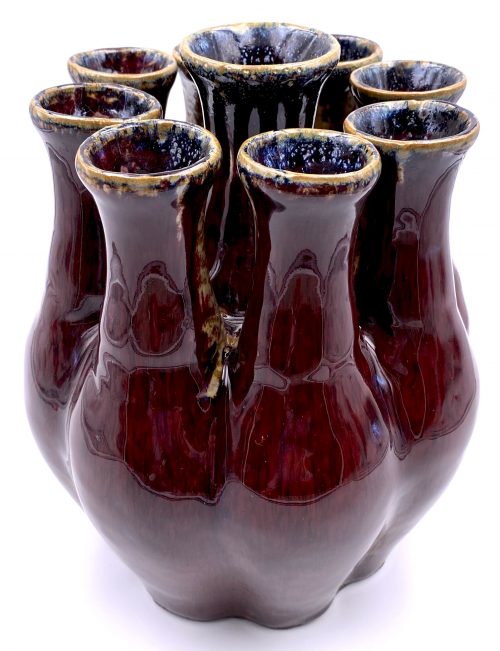 Porcelaneous stoneware vase glazed in purple-red with blue and beige splashes outside and dark blue inside, with one tube in the centre surrounded with eight peripheral tubes. Base unglazed. China, the Qianlong period (1711 – 1799) of the Qing Dynasty (1644 – 1912). Diameter: 19 cm; Height: 24 cm.
Porcelaneous stoneware vase glazed in purple-red with blue and beige splashes outside and dark blue inside, with one tube in the centre surrounded with eight peripheral tubes. Base unglazed. China, the Qianlong period (1711 – 1799) of the Qing Dynasty (1644 – 1912). Diameter: 19 cm; Height: 24 cm. -
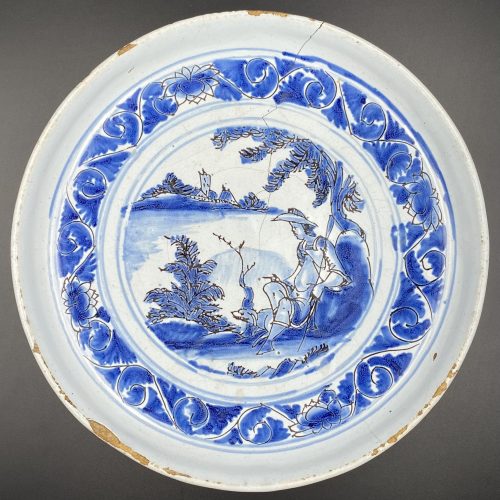 Nevers faience footed plate with a hunter and his dog on a mound, in blue over white. Dimensions: Diameter 22.3 cm; H: 3.5 cm. Seller's description: Plat rond en faïence à décor en camaïeu bleu d'un personnage et son chien sur un tertre feuillagé dans un médaillon, frise d'entrelacs. Fin XVIIème.
Nevers faience footed plate with a hunter and his dog on a mound, in blue over white. Dimensions: Diameter 22.3 cm; H: 3.5 cm. Seller's description: Plat rond en faïence à décor en camaïeu bleu d'un personnage et son chien sur un tertre feuillagé dans un médaillon, frise d'entrelacs. Fin XVIIème. -
 Fuchi: 38 x 22 x 12 mm. Kashira: 32 x 17 x 11 mm Main material: shakudo; surface treatment: nanako-ji; other metals: gold, shibuichi and copper; decorative technique: iroe takazogan. Signed: Nyudo Jounishi 人道 乗西 (possibly)
Fuchi: 38 x 22 x 12 mm. Kashira: 32 x 17 x 11 mm Main material: shakudo; surface treatment: nanako-ji; other metals: gold, shibuichi and copper; decorative technique: iroe takazogan. Signed: Nyudo Jounishi 人道 乗西 (possibly) -
 Yamagane tsuba of round form with design of a 14 petal chrysanthemum (kiku) in cast openwork (sukashi), with slightly raised rounded rim. Early Muromachi period (1393-1457). Size: Height: 64.5 mm; Width: 64.0 mm; Thickness at seppa-dai: 4.1 mm; Weight: 52.5 g. Provenance: Sasano collection (though not illustrated in the book 'Sasano: Japanese Sword Guard Masterpieces from the Sasano Collection, 1994', which only covers tsuba made of iron). Wooden box (tomobako) with inscription (hakogaki) by Sasano Masayuki. References: Illustrated on p. 140 at Tosogu: Treasure of the samurai by Graham Gemmell in the article Muromachi period tsuba by Robin Peverett, London, 1991, pp. 131-145. Sold at Sotheby's, London, Thursday 10 April 1997 Sotheby's, London, 1997 [Japanese Swords and Tsuba from the Professor A.Z. Freeman and the Phyllis Sharpe Memorial collections], p. 16: "A ko-kinko bronze Tsuba, early Muromachi period (1393-1453) of circular form, with raised rounded rim, pierced with kiku petals and with a small elongated kozuka-hitsu, the work appearing to be cast and finished by hand. 6.4cm, thickness at centre 4.15mm, at rim 4.8mm. With a Tomobako, bearing a hakogaki by Masayuki Sasano, with rating Shu. Estimated: £1,000-1,500." Hakogaki (courtesy M. Sesko): 古金工 鐔 Ko-Kinkō tsuba 菊花透 無銘 山銅地透 時代 室町前期 古雅入念 秀作 昭和戊辰年伏月 素心鑑 kikka-sukashi, mumei yamagane, ji-sukashi jidai Muromachi-zenki koga nyūnen, shūsaku Showa tsuchinoe-tatsudoshi fukugetsu Soshinkan Kikka-sukashi, unsigned. Of yamagane and with ji-sukashi. Era is early Muromachi period. Excellent and carefully made work of classical elegance. June in the year of the dragon of the Shōwa era (1988) Soshinkan (pen name of Sasano Masayuki).
Yamagane tsuba of round form with design of a 14 petal chrysanthemum (kiku) in cast openwork (sukashi), with slightly raised rounded rim. Early Muromachi period (1393-1457). Size: Height: 64.5 mm; Width: 64.0 mm; Thickness at seppa-dai: 4.1 mm; Weight: 52.5 g. Provenance: Sasano collection (though not illustrated in the book 'Sasano: Japanese Sword Guard Masterpieces from the Sasano Collection, 1994', which only covers tsuba made of iron). Wooden box (tomobako) with inscription (hakogaki) by Sasano Masayuki. References: Illustrated on p. 140 at Tosogu: Treasure of the samurai by Graham Gemmell in the article Muromachi period tsuba by Robin Peverett, London, 1991, pp. 131-145. Sold at Sotheby's, London, Thursday 10 April 1997 Sotheby's, London, 1997 [Japanese Swords and Tsuba from the Professor A.Z. Freeman and the Phyllis Sharpe Memorial collections], p. 16: "A ko-kinko bronze Tsuba, early Muromachi period (1393-1453) of circular form, with raised rounded rim, pierced with kiku petals and with a small elongated kozuka-hitsu, the work appearing to be cast and finished by hand. 6.4cm, thickness at centre 4.15mm, at rim 4.8mm. With a Tomobako, bearing a hakogaki by Masayuki Sasano, with rating Shu. Estimated: £1,000-1,500." Hakogaki (courtesy M. Sesko): 古金工 鐔 Ko-Kinkō tsuba 菊花透 無銘 山銅地透 時代 室町前期 古雅入念 秀作 昭和戊辰年伏月 素心鑑 kikka-sukashi, mumei yamagane, ji-sukashi jidai Muromachi-zenki koga nyūnen, shūsaku Showa tsuchinoe-tatsudoshi fukugetsu Soshinkan Kikka-sukashi, unsigned. Of yamagane and with ji-sukashi. Era is early Muromachi period. Excellent and carefully made work of classical elegance. June in the year of the dragon of the Shōwa era (1988) Soshinkan (pen name of Sasano Masayuki). -
 Well-forged iron plate of round shape (maru-gata) is decorated with water weeds or arabesque (karakusa) in flat brass inlay (hira-zōgan) all over and eight family crests (mon) of round form in cast brass with delicate linear carving (kebori) and openwork (sukashi). Crests represent: [at 9 hours] three counter-clockwise commas or swirls (tomoe); [at 10:30] plum blossom (ume); [at 12:00, 1:130, and 7:30] - stylized flower made by cutting out five suhama symblos (flower-shaped suhama); [at 3:00] bellflower (kikyō); [at 4:30] seven-star crest (shichiyō-mon); [at 6:00] cherry blossom (sakura). Brass-trimmed ryo-hitsu. Copper sekigane. Yoshirō school. Momoyama or early Edo period, end of the 16th to first half of the 17th century (1574-1650). Inscription on seppa-dai: 八幡 - Hachiman. Size: height 89.6 mm, width 89.3 mm, thickness at seppa-dai 3,0 mm. Weight 129.7 g. NBTHK certificate № 4007685, June 27, 2015: HOZON (Worthy of Preservation). As for the inscription, Nihonto Message Board blog discussion provides the following explanation of the inscription: "An expression of conviction as to being the best under the sun". On the other hand, there may be more in this confluence of symbols: the tomoe crest at 9:00 is "the kamon of Hachiman, the war god" [Family Crests of Japan; Stone Bridge Press, Berkeley, CA, 2007, p. 108]. The character 八 in the inscription cut stronger than the other kanji, and may be by a different hand in different time. 八 (hachi, eight): "The numeral eight was appreciated because its shape broadens toward the bottom, symbolizing eternal expansion" [ibid, p. 119]. It may be said that this tsuba is dedicated to Hachiman. Other crests (suhama, bellflower, seven-stars, plum and cherry blossoms) collectively allude to "good old times" when Fijiwara and Taira clans were in full bloom. Markus Sesko believes that the inscriptions reads: Hachiman: "the inscription is/was HACHIMAN (八幡), the God of War and a relatively popular inscription for tsuba, swords and armor." Elliott Long and Robert Haynes provide the following explanation of the inscription: "...hachi is correct and represents the name of the HACHI SHRINE. The inscription reads 'YAWATA' which is the name of the mountain in Mino Province where the HACHI Shrine is located". Details on Hachiman Shrine in Yawata (八幡市) can be found elsewhere, including Historical and geographical dictionary of Japan by Edmond Papinot. Van Ham auction house provides the following description: MON-SUKASHI TSUBA. MARUGATA. Japan. Momoyama period. Yoshiro school. Iron with inlays of brass. In hira-zogan technique with kebori engraving eight different family emblems (mon). An old inscription is dedicated to the deity Hachiman. D.4.5mm, Ø 8.3cm. Condition A/B. Supplement: Wooden box and NBTHK certificate.
Well-forged iron plate of round shape (maru-gata) is decorated with water weeds or arabesque (karakusa) in flat brass inlay (hira-zōgan) all over and eight family crests (mon) of round form in cast brass with delicate linear carving (kebori) and openwork (sukashi). Crests represent: [at 9 hours] three counter-clockwise commas or swirls (tomoe); [at 10:30] plum blossom (ume); [at 12:00, 1:130, and 7:30] - stylized flower made by cutting out five suhama symblos (flower-shaped suhama); [at 3:00] bellflower (kikyō); [at 4:30] seven-star crest (shichiyō-mon); [at 6:00] cherry blossom (sakura). Brass-trimmed ryo-hitsu. Copper sekigane. Yoshirō school. Momoyama or early Edo period, end of the 16th to first half of the 17th century (1574-1650). Inscription on seppa-dai: 八幡 - Hachiman. Size: height 89.6 mm, width 89.3 mm, thickness at seppa-dai 3,0 mm. Weight 129.7 g. NBTHK certificate № 4007685, June 27, 2015: HOZON (Worthy of Preservation). As for the inscription, Nihonto Message Board blog discussion provides the following explanation of the inscription: "An expression of conviction as to being the best under the sun". On the other hand, there may be more in this confluence of symbols: the tomoe crest at 9:00 is "the kamon of Hachiman, the war god" [Family Crests of Japan; Stone Bridge Press, Berkeley, CA, 2007, p. 108]. The character 八 in the inscription cut stronger than the other kanji, and may be by a different hand in different time. 八 (hachi, eight): "The numeral eight was appreciated because its shape broadens toward the bottom, symbolizing eternal expansion" [ibid, p. 119]. It may be said that this tsuba is dedicated to Hachiman. Other crests (suhama, bellflower, seven-stars, plum and cherry blossoms) collectively allude to "good old times" when Fijiwara and Taira clans were in full bloom. Markus Sesko believes that the inscriptions reads: Hachiman: "the inscription is/was HACHIMAN (八幡), the God of War and a relatively popular inscription for tsuba, swords and armor." Elliott Long and Robert Haynes provide the following explanation of the inscription: "...hachi is correct and represents the name of the HACHI SHRINE. The inscription reads 'YAWATA' which is the name of the mountain in Mino Province where the HACHI Shrine is located". Details on Hachiman Shrine in Yawata (八幡市) can be found elsewhere, including Historical and geographical dictionary of Japan by Edmond Papinot. Van Ham auction house provides the following description: MON-SUKASHI TSUBA. MARUGATA. Japan. Momoyama period. Yoshiro school. Iron with inlays of brass. In hira-zogan technique with kebori engraving eight different family emblems (mon). An old inscription is dedicated to the deity Hachiman. D.4.5mm, Ø 8.3cm. Condition A/B. Supplement: Wooden box and NBTHK certificate. -

Iron tsuba of square with cut-off edges form (sumi-iri-kakugata) with lattice design in openwork (sukashi) and solid center. Hitsu-ana plugged with lead.
Unsigned. Late Muromachi period, ca. 16th century.
Size: 81.3 x 80.0 x 3.6 mm References: 1) Tsuba Kanshoki. Kazutaro Torogoye, 1975, p. 95, lower image. It's also called Kyō shōami. 2) KTK-11: Koshi motif, Late Muromachi (16th c.) -
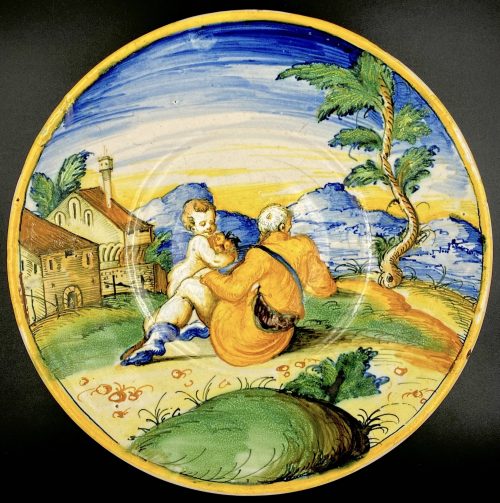
-
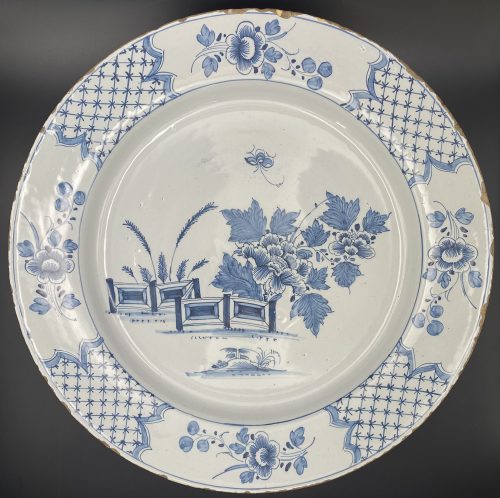 Round plate with a blue and white design of blossoming peony behind a fence with lattice and floral border; flowers to the bottom. Diameter: 33 cm, Haight: 4.5 cm.
Round plate with a blue and white design of blossoming peony behind a fence with lattice and floral border; flowers to the bottom. Diameter: 33 cm, Haight: 4.5 cm. -
 Iron tsuba of the round form (maru gata) with a grey patina pierced with the design of slanting rays of light (Jesuit’s IHS symbol) and a pair of ginger symbols [茗荷] (myōga) at top and bottom, in positive silhouette (ji-sukashi). This design is often called “tokei” [時計] or “clock gear”. Rounded rim, large hitsu-ana, copper fittings (sekigane). Unsigned, unpapered. Owari school. Early Edo period, early 17th century.
Iron tsuba of the round form (maru gata) with a grey patina pierced with the design of slanting rays of light (Jesuit’s IHS symbol) and a pair of ginger symbols [茗荷] (myōga) at top and bottom, in positive silhouette (ji-sukashi). This design is often called “tokei” [時計] or “clock gear”. Rounded rim, large hitsu-ana, copper fittings (sekigane). Unsigned, unpapered. Owari school. Early Edo period, early 17th century.Size: H 71.9 x W 71.1 x Th (centre) 5.5 cm.
For information regarding this type of tsuba see the article 'Kirishitan Ikenie Tsuba by Fred Geyer at Kokusai Tosogu Kai; The 2nd International Convention & Exhibition, October 18-23, 2006, pp. 84-91. 
IHS emblem of the Jesuits

茗荷 Myoga or Japanese ginger
-
 Iron tsuba of slightly elongated round form decorated with design of melon flowers, vines, and leaves in brass flat inlay (hira-zōgan) on both sides. Slightly raised rim (mimi) carved in a way to simulate ring-shaped covering (fukurin). Kozuka hitsu-ana and kogai hitsu-ana both plugged with soft metal (tim or lead). Copper sekigane. Heianjō or Kaga School. Muromachi or Momoyama period, 16th century. Iron, hira-zōgan brass inlay. Round (maru gata) form, diameter 79 mm. Size: 80.3 x 78.4 mm; thickness at seppa-dai: 3.4 mm; at the middle: 3.8 mm; before the rim: 2.4 mm, rim: 2.8 mm. Note on design: though this design resembles family crests with oak and mulberry leaves, I believe it's a melon flower [see Jeanne Allen. Designer's guide to Samurai Patterns. Chronicle Books, San Francisco, 1990, page 114, №130 "Melon Flowers":Note about the distribution of thickness (niku-oki): "this tsuba has toroid features, niku raises from the rim towards the centre but thins once more out when approaching the seppa-dai" [M. Sesko, "Handbook...", p. 48].
Iron tsuba of slightly elongated round form decorated with design of melon flowers, vines, and leaves in brass flat inlay (hira-zōgan) on both sides. Slightly raised rim (mimi) carved in a way to simulate ring-shaped covering (fukurin). Kozuka hitsu-ana and kogai hitsu-ana both plugged with soft metal (tim or lead). Copper sekigane. Heianjō or Kaga School. Muromachi or Momoyama period, 16th century. Iron, hira-zōgan brass inlay. Round (maru gata) form, diameter 79 mm. Size: 80.3 x 78.4 mm; thickness at seppa-dai: 3.4 mm; at the middle: 3.8 mm; before the rim: 2.4 mm, rim: 2.8 mm. Note on design: though this design resembles family crests with oak and mulberry leaves, I believe it's a melon flower [see Jeanne Allen. Designer's guide to Samurai Patterns. Chronicle Books, San Francisco, 1990, page 114, №130 "Melon Flowers":Note about the distribution of thickness (niku-oki): "this tsuba has toroid features, niku raises from the rim towards the centre but thins once more out when approaching the seppa-dai" [M. Sesko, "Handbook...", p. 48].
Jeanne Allen. Designer's guide to Samurai Patterns. Chronicle Books, San Francisco, 1990. Page 114, №130.
-
 Onin Tsuba with two overlapping lozenges, or interlocked diamond shapes. Iron and brass. Sukashi and ten-zogan technique. Muromachi period. Diameter: 81.0 mm; Thickness at seppa-dai: 3.2 mm The symbol of two overlapping lozenges (or, interlocked diamond shapes), presumably a family crest (kamon) may be deciphered as chigai kuginuki (nail extraction tool => 'conquered nine castles' ) or as chigai bishi (overlapping lozenges). Similar symbol can be found at Butterfield & Butterfield. IMPORTANT JAPANESE SWORDS, SWORD FITTINGS AND ARMOR. Auction Monday, November 19th, 1979. Sale # 3063], №94 with the following explanation: " This was the mon (crest) of the Yonekura family of Kaga Prov., at Kanazawa". An interesting insight is provided by Robert E. Haynes at Important Japanese kodogu, gaiso and works of art. San Francisco, April 9-11, 1982. Robert E. Haynes, Ltd., № 36 (see photo): "This would seem to be the Yonekura family mon. They were Seiwa-Genji Daimyō family made noble in 1696 and resided in Kanazawa in Kaga". Would it be possible that this is a late 17th century Ōnin tsuba?
Onin Tsuba with two overlapping lozenges, or interlocked diamond shapes. Iron and brass. Sukashi and ten-zogan technique. Muromachi period. Diameter: 81.0 mm; Thickness at seppa-dai: 3.2 mm The symbol of two overlapping lozenges (or, interlocked diamond shapes), presumably a family crest (kamon) may be deciphered as chigai kuginuki (nail extraction tool => 'conquered nine castles' ) or as chigai bishi (overlapping lozenges). Similar symbol can be found at Butterfield & Butterfield. IMPORTANT JAPANESE SWORDS, SWORD FITTINGS AND ARMOR. Auction Monday, November 19th, 1979. Sale # 3063], №94 with the following explanation: " This was the mon (crest) of the Yonekura family of Kaga Prov., at Kanazawa". An interesting insight is provided by Robert E. Haynes at Important Japanese kodogu, gaiso and works of art. San Francisco, April 9-11, 1982. Robert E. Haynes, Ltd., № 36 (see photo): "This would seem to be the Yonekura family mon. They were Seiwa-Genji Daimyō family made noble in 1696 and resided in Kanazawa in Kaga". Would it be possible that this is a late 17th century Ōnin tsuba?
Robert E. Haynes Catalog of April 9-11, 1982, № 36.
-
 Iron tsuba of half round and half lobed (chrysanthemoid) form decorated with plants and family crests (mon) in cast brass inlay (suemon-zōgan), and scattered brass dots inlay (ten-zōgan); brass wire inlay outlining the rim, seppa-dai, and hitsu-ana (scalloped wire) on both sides. Surface treated with hummer punch marks. The chrysanthemoid half of the plate chiseled with thin shallow grooves, outlining the petals. Copper sekigane. On the face the inlay represents: mandarin orange (tachibana), half karahana, encircled bellflower, and four encircled three-stipe family crest (mitsubiki-mon of Sakuma and Abe clans, and some others). On the reverse the design is similar but two of the mitsubiki-mon symbols replaced with two comb-shaped Genji-mon ideographs. Ōnin school. The end of mid-Muromachi period, beginning of the 16th century. Size: 74.3 x 72.7 x 2.4 mm.
Iron tsuba of half round and half lobed (chrysanthemoid) form decorated with plants and family crests (mon) in cast brass inlay (suemon-zōgan), and scattered brass dots inlay (ten-zōgan); brass wire inlay outlining the rim, seppa-dai, and hitsu-ana (scalloped wire) on both sides. Surface treated with hummer punch marks. The chrysanthemoid half of the plate chiseled with thin shallow grooves, outlining the petals. Copper sekigane. On the face the inlay represents: mandarin orange (tachibana), half karahana, encircled bellflower, and four encircled three-stipe family crest (mitsubiki-mon of Sakuma and Abe clans, and some others). On the reverse the design is similar but two of the mitsubiki-mon symbols replaced with two comb-shaped Genji-mon ideographs. Ōnin school. The end of mid-Muromachi period, beginning of the 16th century. Size: 74.3 x 72.7 x 2.4 mm. -

Iron tsuba of mokko form with rough surface decorated in low relief carving (sukidashi-bori) and openwork (sukashi) with a flying bat, a crescent moon, and a cloud over the moon. Bat's eyes inlaid with gold. Crescent moon and cloud on the reverse. Copper sekigane. Kogai hitsu-ana plugged with shakudō.
Unsigned.
Edo period.Size: Height: 83.7 mm; Width: 80.3 mm; Thickness: 2.9 mm; Weight: 141 g.
-
 Iron tsuba of octafoil form with design of rudder (kaji) and lake in openwork (sukashi) outlined with brass wire. Thin plate also decorated with three concentric circular rows of brass dots (nail heads) in ten-zōgan. Center of the plate outlined with the inlaid circular brass wire. Cut-outs for kozuka and kogai probably added later. Slightly raised rim between the indentations (suki-nokoshi-mimi). The inlaid metal of red-ish hue, so it may be copper, not brass. Sekigane, visible on the NBTHK paper photo, are missing, possibly removed by a previous owner. Muromachi period. Ōnin school. Unsigned. Dimensions: 81.2 mm x 81.8 mm x 2.7 mm. Weight: 79.0 g. Large nakago-ana: 34 mm high and 10 mm wide. NBTHK certificate №455786: Hozon. Note regarding design: it was quite hard to interpret the big oval opening. The first suggestion was 'sea cucubmer', and it was based on a design published by Kazutaro Torigoye [Kodogu and tsuba. International collections not published in my books (Toso Soran), 1978] on page 202: Katchūshi tsuba: Sea cucumber and butterfly. Look and judge yourself:The second suggestion - 'lake' - came from [Iron tsuba. The works of the exhibition "Kurogane no hana", The Japanese Sword Museum, 2014], page 14 №5:
Iron tsuba of octafoil form with design of rudder (kaji) and lake in openwork (sukashi) outlined with brass wire. Thin plate also decorated with three concentric circular rows of brass dots (nail heads) in ten-zōgan. Center of the plate outlined with the inlaid circular brass wire. Cut-outs for kozuka and kogai probably added later. Slightly raised rim between the indentations (suki-nokoshi-mimi). The inlaid metal of red-ish hue, so it may be copper, not brass. Sekigane, visible on the NBTHK paper photo, are missing, possibly removed by a previous owner. Muromachi period. Ōnin school. Unsigned. Dimensions: 81.2 mm x 81.8 mm x 2.7 mm. Weight: 79.0 g. Large nakago-ana: 34 mm high and 10 mm wide. NBTHK certificate №455786: Hozon. Note regarding design: it was quite hard to interpret the big oval opening. The first suggestion was 'sea cucubmer', and it was based on a design published by Kazutaro Torigoye [Kodogu and tsuba. International collections not published in my books (Toso Soran), 1978] on page 202: Katchūshi tsuba: Sea cucumber and butterfly. Look and judge yourself:The second suggestion - 'lake' - came from [Iron tsuba. The works of the exhibition "Kurogane no hana", The Japanese Sword Museum, 2014], page 14 №5:
Torigoye: sea cucumber and butterfly.
Opening on my tsuba looks more like the 'lake'. Also, rudder and lake make more sense than rudder and sea cucumber. At least to me...
Ko-Katchūshi tsuba: Lake and pine.
-
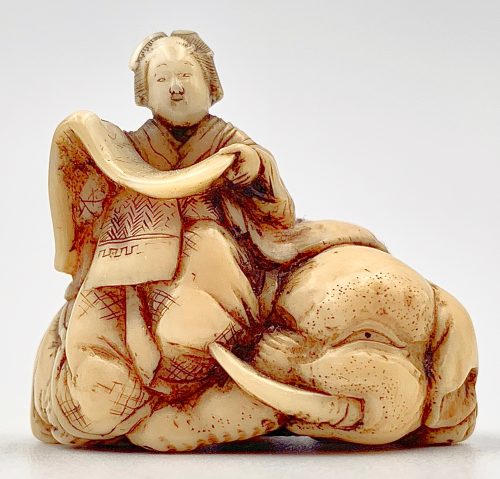 Netsuke of Kimi no Eguchi on a recumbent elephant. Signed: Toun. Circa 1850. 33.7 x 30.8 x 22.7 mm. The Courtesan Eguchi no kimi as Fugen, Bodhisattva of Universal Wisdom (Eguchi no kimi mitate Fugen Bosatsu). The imagery satirizes the Buddhist bodhisattva Fugen, whose iconographic mount is an elephant, by replacing the deity with a beautifully coiffed modern courtesan. Such a visual pun (mitate) was an artistic trope, popular in the Edo period. Provenance: Charles Ephrussi (1849-1905) acquired in the 1870s; a wedding gift in 1898 to his cousin Ritter Viktor von Ephrussi (1860-1945) and Baroness Emilie (Emmy) Schey von Koromla (1879-1938); retrieved post-war by their daughter Elizabeth de Waal (1899-1991); given by her to her brother Ignaz (Iggie) Ephrussi (1906-1994), Tokyo; bequeathed by him to his great-nephew Edmund de Waal (born 1964), London, author of "The Hare with Amber Eyes: a hidden inheritance". London / New York: Chatto & Windus / Farrar, Straus & Giroux. ISBN 978-0099539551. https://en.wikipedia.org/wiki/Charles_Ephrussi. https://en.wikipedia.org/wiki/Ephrussi_family. https://en.wikipedia.org/wiki/Edmund_de_Waal.
Netsuke of Kimi no Eguchi on a recumbent elephant. Signed: Toun. Circa 1850. 33.7 x 30.8 x 22.7 mm. The Courtesan Eguchi no kimi as Fugen, Bodhisattva of Universal Wisdom (Eguchi no kimi mitate Fugen Bosatsu). The imagery satirizes the Buddhist bodhisattva Fugen, whose iconographic mount is an elephant, by replacing the deity with a beautifully coiffed modern courtesan. Such a visual pun (mitate) was an artistic trope, popular in the Edo period. Provenance: Charles Ephrussi (1849-1905) acquired in the 1870s; a wedding gift in 1898 to his cousin Ritter Viktor von Ephrussi (1860-1945) and Baroness Emilie (Emmy) Schey von Koromla (1879-1938); retrieved post-war by their daughter Elizabeth de Waal (1899-1991); given by her to her brother Ignaz (Iggie) Ephrussi (1906-1994), Tokyo; bequeathed by him to his great-nephew Edmund de Waal (born 1964), London, author of "The Hare with Amber Eyes: a hidden inheritance". London / New York: Chatto & Windus / Farrar, Straus & Giroux. ISBN 978-0099539551. https://en.wikipedia.org/wiki/Charles_Ephrussi. https://en.wikipedia.org/wiki/Ephrussi_family. https://en.wikipedia.org/wiki/Edmund_de_Waal. -
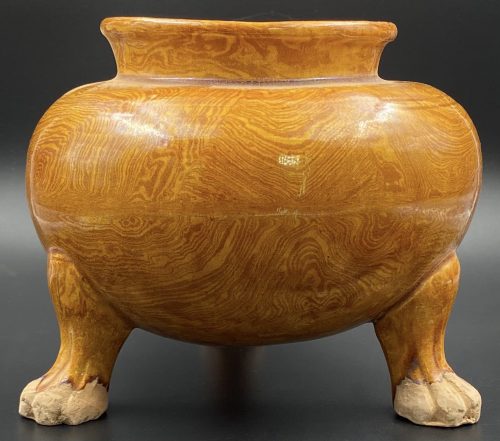 Amber-glazed marbled pottery tripod censer, standing on unglazed beast's paws. The clay itself is not marbled, only the glaze. China, the Tang dynasty [唐朝] (618 – 907). Diameter: 16 cm; Height: 14 cm.
Amber-glazed marbled pottery tripod censer, standing on unglazed beast's paws. The clay itself is not marbled, only the glaze. China, the Tang dynasty [唐朝] (618 – 907). Diameter: 16 cm; Height: 14 cm. -
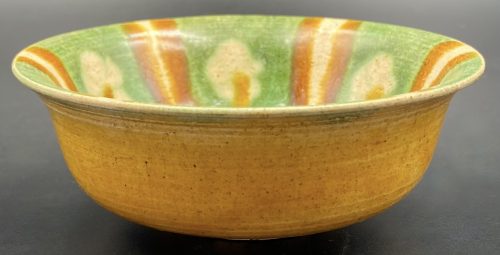 Small stoneware cup with rounded sides raising from a short foot to an inverted rim; glazed inside with a cream and brown six-petal design on a green background with cream and brown stylized flowers. Amber glaze outside, blue bottom, foot unglazed. Dia: 10 cm; H: 4 cm.
Small stoneware cup with rounded sides raising from a short foot to an inverted rim; glazed inside with a cream and brown six-petal design on a green background with cream and brown stylized flowers. Amber glaze outside, blue bottom, foot unglazed. Dia: 10 cm; H: 4 cm. -
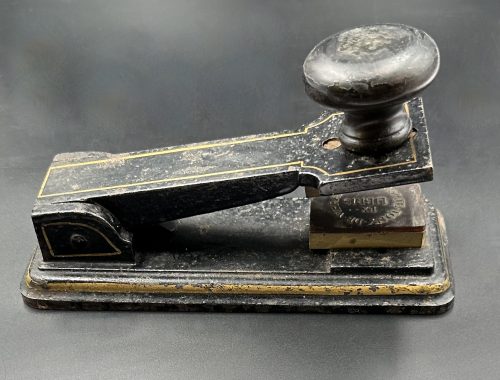 Iron pliers painted black and outlined in gilt lacquer, with wooden handle and bronze seals, "Ex Libris Comte Tony de Vibraye", L17.1 x W6.9 x H7.5 cm. Provenance: Antoine Henri Gaston Hurault de Vibraye [Comte Tony de Vibraye] (French, 1893 – 1951). The book with such a stamp in this library: [LIB-3243.2023] Crébillon fils. La Nuit et le moment ou Les Matinées de Cythère / Illustrations de Sylvain Sauvage. — Paris: Au dépens d’un amateur, 1924.
Iron pliers painted black and outlined in gilt lacquer, with wooden handle and bronze seals, "Ex Libris Comte Tony de Vibraye", L17.1 x W6.9 x H7.5 cm. Provenance: Antoine Henri Gaston Hurault de Vibraye [Comte Tony de Vibraye] (French, 1893 – 1951). The book with such a stamp in this library: [LIB-3243.2023] Crébillon fils. La Nuit et le moment ou Les Matinées de Cythère / Illustrations de Sylvain Sauvage. — Paris: Au dépens d’un amateur, 1924. -
 A yamagane (unrefined copper) ko-kinko tsuba of slightly elongated round form with design of wisteria carved in sculptural relief (nikubori). Copper sekigane. Unsigned. Muromachi period, likely the 16th century.
A yamagane (unrefined copper) ko-kinko tsuba of slightly elongated round form with design of wisteria carved in sculptural relief (nikubori). Copper sekigane. Unsigned. Muromachi period, likely the 16th century.Size: 74.3 x 71.8 x 3.2 mm.
NBTHK certificate №4003986: Hozon (worthy preservation). In custom wooden box.


